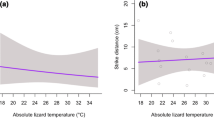Summary
Thermo sensitive transmitters were used in a study on free-ranging smooth snakes (Coronella austriaca). Except on cold cloudy days, this snake shows a daily tripartite pattern of body temperatures. The pattern consists of a quick rise in body temperature in the morning, a subsequent stable phase during which body temperatures vary between 29 and 33° C, and finally a drop of body temperatures in the evening. The, consistency of the stable phase over the study period indicates that this range represents the thermal preferendum of this species. During the succesive study months a time shift in daily activity pattern was observed.
Similar content being viewed by others
References
Aleksiuk M (1976) Metabolic and behavioural adjustments to temperature change in the red sided garter snake (Thamnophis sirtalis parietalis): an integrated approach. J Thermal Biol 1(3):153–156
Andren C, Nilson G (1976) Hasselsnoken (Coronella austriaca) — en utrotningshitad ormart. Fauna och Flora 71(2):61–76
Avery RA (1971) Estimates of food consumption by the lizard Lacerta vivipara Jacquin. J Anim Ecol 40:351–365
Avery RA, McArdle BH (1973) The morning emergence of the lizard Lacerta vivipara Jacquin. Br J Herpetol 5:363–368
Bont RG de, Gelder JJ van Olders JHJ (1984) Gewichtsverloop en lichaamstemperaturen van de gladde slang (Coronella austriaca) in het voorjaar. Lacerta 42(7):124–129
Brattstrom BH (1965) Body temperatures of reptiles. Amer Midl Nat 73:376–422
Brown WS, Parker WS (1976) Movement ecology of Coluber constrictor near communal hibernacula. Copeia 1976(2):225–242
Brown WS, Pyle DW, Greene KR, Friedlaender JB (1982) Movements and temperature relationships of timber rattlesnakes (Crotalus horridus) in north-eastern New York. J Herpetol 16(2):151–161
Fitch HS, Shirer HW (1971) A radiotelemetric study of spatial relationships in some common snakes. Copeia 1971:118–128
Gibson AR, Falls JB (1979) Thermal biology of, the common garter snake Thamnophis sirtalis (L.). 1. Temporal variation, environmental effects and sex differences. Oecologia (Berlin) 43:79–97
Greenwald OE, Kanter ME (1979) The effects of temperature and behavioral thermoregulation on digestive efficiency and rate in corn snakes, Elaphe guttata guttata. Physiol Zool 52:398–408
Hammerson GA (1979) Thermal ecology of the striped racer, Masticophis lateralis (Serpentes, Colubridae). Herpetologica 35:267–273
Heatwole H (1976) Reptile ecology. St. Lucia, Queensland: University of Queensland Press
Henderson RW (1982) Thermoregulation in a Hispaniolan tree snake, Uromacer catesbyl. J Herpetol 16(1):89–91
Huey RB, Pianka ER, Hoffman JA (1977) Seasonal variation in thermoregulatory behavior and body temperature of diurnal Kalahari lizards. Ecology 58:1066–1075
Jacob JS, Painter CW (1980) Overwinter thermal ecology of Crotalus viridis in the north-central plains of New Mexico. Copeia 1980(4):799–805
Lillywhite HB (1980) Behavioral thermoregulation in Australian elapid snakes. Copeia 1980(3):452–458
Moore RG (1978) Seasonal and daily activity patterns and thermoregulation in the south western speckled rattlesnake (Crotalus mitchelli pyrrhus) and the Colorado desert sidewinder (Crotalus cerastes laterorepens). Copeia 1978:439–442
Olders JHJ, Gelder JJ van, Krammer J (1986) A thermo-sensitive transmitter for radio tracking small animals. Accepted for publication in Neth. J of Zool
Osgood DW (1970) Thermoregulation in water snakes studied by telemetry. Copeia 1970:568
Ruben JA (1976) Reduced nocturnal heat loss associated with ground litter burrowing by the California red-sided garter snake, Thamnophis sir talis infernalis. Herpetologica 32:323–325
Smith EN (1979) Behavioral and physiological thermoregulation of crocodilians. Am Zool 19:239–247
Spellerberg IF (1976) Adaptations of reptiles to cold. In: d'A Bellairs A, Cox CB (eds) Morphology and Biology of Reptiles. Linnean Society Symposium Series Number 3 pp 261–285
Spellerberg IF, Phelps TE (1975) Voluntary temperatures of the snake, Coronella austriaca. Copeia 1975(1):183–185
Spellerberg, IF, Phelps TE (1977) Biology, general ecology and behaviour of the snake, Coronella austriaca Laurenti. Biol J Linn Soc 9:133–164
Waldschmidt S (1980) Orientation to the sun by the iguanid lizards Uta stansburiana and Sceloporus undulatus: hourly and monthly variations. Copeia 1980:458–462
Author information
Authors and Affiliations
Rights and permissions
About this article
Cite this article
de Bont, R.G., van Gelder, J.J. & Olders, J.H.J. Thermal ecology of the smooth snake, Coronella austriaca Laurenti, during spring. Oecologia 69, 72–87 (1986). https://doi.org/10.1007/BF00399040
Received:
Issue Date:
DOI: https://doi.org/10.1007/BF00399040




